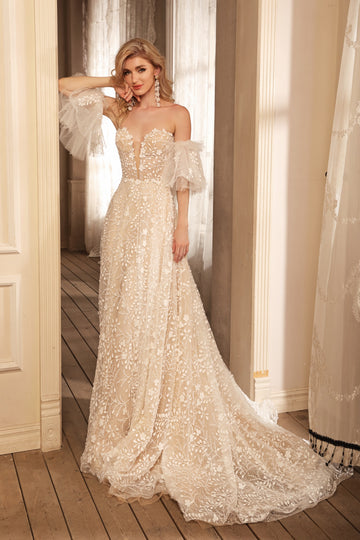Glimpses of History Through Wedding Dress Styles: A Timeless Journey
Glimpses of History Through Wedding Dress Styles: A Timeless Journey
Weddings are moments of joy and celebration, and one of the most significant elements that symbolize this special occasion is the wedding dress. Over the centuries, wedding dress styles have evolved dramatically, reflecting changing cultural norms, societal values, and fashion trends. In this article, we will explore the fascinating historical journey of wedding dress styles, offering glimpses into the past that inform the bridal fashion of today.
The Evolution of Wedding Dress Styles
The history of wedding dresses is as rich as it is diverse. From the ancient Egyptians to the modern-day bride, each era has its unique take on what constitutes the perfect wedding attire. Let’s take a closer look at the progression of wedding dress styles through different periods:
| Era | Style Characteristics | Influences |
| Ancient Times | Simple fabrics, often in white or cream. | Religious and cultural significance. |
| Middle Ages | Rich colors, elaborate embroidery, veils were common. | Royal influences, feudal society. |
| Victorian Era | Full skirts, corsets, lace, and long trains. | Queen Victoria's white wedding dress, industrial revolution. |
| 20th Century | Flapper influences, A-line silhouettes, shorter hemlines. | Cultural shifts, World Wars. |
| Modern Day | Diverse styles, inclusivity, and emphasis on individuality. | Globalization and celebrity influence. |
Ancient Wedding Attire
In ancient civilizations, the concept of a wedding dress was markedly different. For example, in Ancient Egypt, brides typically wore simple linen dresses, often in shades of white or cream that were both practical and symbolic of purity. These garments were usually unadorned, as the focus was on the ceremonial aspects of the union rather than the attire itself.
The Middle Ages: A Shift in Tradition
As we transition into the Middle Ages, the wedding attire began to reflect more of the era's social hierarchies and personal wealth. Brides wore gowns that were rich in color and fabric. Velvet and satin became popular, complemented by long flowing veils. The veil symbolized modesty and virtue, and was often adorned with intricate embroidery. Marriages during this time were often driven by alliances and property rather than love, making the wedding dress a reflection of family status.

The Victorian Era: A Revolutionary Change
One cannot discuss wedding dress history without mentioning Queen Victoria, whose choice of a white wedding gown shocked the world in 1840. Prior to her choice, brides often wore their best dresses, which could be of any color. Queen Victoria's white satin gown set the standard and made white the dominant color for wedding dresses. The Victorian era’s wedding dresses were characterized by full skirts, corseted waists, and detailed embellishments, setting a precedent for centuries to come.
The Roaring Twenties: Embracing Change
The 1920s brought about a significant shift in women’s fashion and societal roles. The flapper style influenced wedding dress designs, which featured shorter hemlines and looser silhouettes that allowed for freedom of movement. The emphasis shifted toward comfort and individual expression rather than strict adherence to tradition.
Modern Day Weddings: A Blend of Tradition and Individuality
In the present day, wedding dress styles are a melting pot of cultural influences, personal choices, and fashion trends. Modern brides often seek gowns that reflect their unique personalities, moving away from conventional styles. Designers now provide options ranging from bohemian lace dresses to sleek, modern ensembles. The availability of diverse styles has made weddings more inclusive, allowing brides of all backgrounds to express themselves through their choice of attire.
Global Influences on Wedding Dress Styles
Wedding dress styles are not only influenced by historical contexts but also by geographical and cultural factors. For instance, traditional Chinese wedding attire features a red qipao, symbolizing luck and happiness. In contrast, Indian weddings may showcase vivid colors and elaborate embroidery, with brides often adorning sarees or lehengas. Today, multicultural weddings have become prevalent, leading to a fascinating fusion of wedding styles.
Famous Wedding Dresses Through Time
Throughout history, several wedding dresses have gained iconic status. For example, Grace Kelly’s 1956 gown, characterized by its lace sleeves and high neckline, remains a reference point for timeless elegance. Similarly, Kate Middleton’s Alexander McQueen wedding dress in 2011 drew inspiration from the Victorian era, highlighting the enduring influence of history on contemporary bridal fashion.
Understanding Modern Trends
The modern bride often faces the challenge of choosing a wedding dress amid an abundance of styles and trends. Here are some current trends to consider:
- Boho Chic: This style emphasizes free-spiritedness and often incorporates lace, flowing fabrics, and unique patterns.
- Minimalist: For those who prefer simplicity, clean lines and subtle elegance are in vogue.
- Sustainable Choices: Eco-friendly fabrics and designs are gaining popularity among environmentally conscious brides.
Conclusion: Embracing Tradition While Looking Forward
Glimpses of history through wedding dress styles reveal how deeply intertwined our past is with present and future bridal fashions. As we explore different wedding dress eras, it becomes clear that each style is a reflection of the societal context in which it emerged. Whether you are drawn to the vintage allure of a Victorian wedding dress or the modern sophistication of today’s trends, it’s essential to remember that your wedding attire is an expression of your identity and values.
As you prepare for your special day, consider combining elements from the past with your personal style. This blend will not only honor the rich heritage of wedding attire but also create a unique statement that is entirely your own. Reflect upon your choices, embrace the rich history, and make your wedding day a true celebration of love and individuality.
Remember to consult with professionals, explore various styles, and perhaps even consider a custom design that speaks to both your history and your personal narrative. Happy planning!
